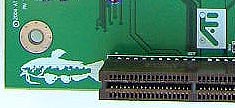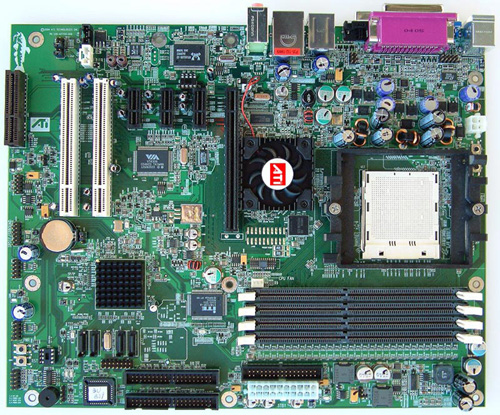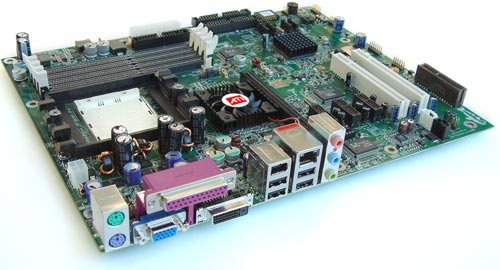ATI Radeon Xpress 200: Performance, PCI Express & DX9 for Athlon 64
by Wesley Fink on November 8, 2004 6:00 AM EST- Posted in
- CPUs
ATI Bullhead Reference Board: Basic Features
ATI calls their new ATI RX480 Reference Board the "Bullhead", and it even carries a logo of a Bullhead fish on the motherboard.
The Bullhead is an extremely wide-ranging variety of fish related to channel catfish. There is probably a lot more to the story.
| ATI RS480 Reference Board Specifications | |
| CPU Interface | Socket 939 Athlon 64 |
| Chipset | RS480/SB400 |
| Bus Speeds | 200MHz to 320MHz |
| PCI Express Speeds | PCIe FIX at 100MHz to 200MHz (in 1MHz increments) |
| Core Voltage | 1.0V to 1.7V in 0.025V increments |
| CPU Clock Multiplier | 4X-25.5X in 0.5X increments |
| CPU Auto Tuning | Off to 15% in 1% increments |
| HyperTransport Frequency | 1000MHz (1GHz) |
| HyperTransport Multiplier | 1X, 2X, 4X, 5X |
| DRAM Voltage | 2.6V, 2.85V |
| AGP Voltage | None available on Reference Board |
| HyperTransport Voltage | None available on Reference Board |
| Memory Slots | Four 184-pin DDR DIMM Slots Dual-Channel Configuration Regular Unbuffered Memory to 4GB Total |
| Expansion Slots | 1 x16 PCIe Slot 3 x1 PCIe Slots 2 PCI Slots 1 Dedicated Communications Riser |
| Onboard SATA/SATA RAID | 4 Drives by SB400 (RAID 0, 1) |
| Onboard IDE/IDE RAID | Two Standard ATA133/100/66 (4 drives) |
| Onboard USB 2.0/IEEE-1394 | 8 USB 2.0 ports supported by SB400 2 Firewire 1394A by VIA VT6306 |
| Onboard LAN | 1Gigabit Ethernet by Realtek 8110S-32 |
| Onboard Audio | AC '97 2.3 8-Channel by Realtek ALC655 |
| BIOS Revision | AMI AMBU-B10 11/02/2004 |
The ATI Bullhead Reference Board is truly unique among the Reference boards that we have tested. Normally, the Reference Board is devoid of BIOS adjustments and overclocking controls that may later appear on boards designed with the Reference chipset. The ATI Bullhead, on the other hand, is loaded with a huge range of controls that will make any enthusiast happy. It is very clear that ATI's goal was to demonstrate, on the front end, that their new chipset for AMD Athlon 64 can hold its own against any competition in the market. Given the enthusiast orientation of some other chipsets for Athlon 64, this was a very smart move by ATI. While ATI is well-known in the OEM market, this attention to flexible ranges and useful overclocking controls announces to the market that ATI intends to be a serious player in the Athlon 64 enthusiast arena.
As a result of the attention that ATI has lavished on the Bullhead, we have the capabilities of testing the overclocking capabilities and memory stress testing that are normally not possible with a Reference design.

The ATI Bullhead is generally very well laid out - much better than we normally see in Reference boards. The power connectors are in the best position on board edges to ease power cable routing. The Hard Disks and SATA locations are reasonable. Even the floppy connector is in a better mid-board location instead of the bottom location that creates a challenge on many new boards. Manufacturers would do well to copy the ATI Bullhead Reference design. No board is perfect in layout, but the Bullhead is very easy to work with in most cases.

ATI also included a full range of IO ports on the Bullhead Reference board. Additional audio connectors are available on a port header in the dedicated CNR slot. The range of options and ports is unusually complete for a Reference board. Once again, the Reference design is worth copying by manufacturers. Perhaps ATI realized that without the chipset history of nVidia or VIA, they would have to work harder to get the market to take ATI seriously as a chipset option. One clever way to accomplish that is to deliver a Reference board that can be put into production by manufacturers without much, if any, redesign. It works for graphics cards, and it can certainly also work for motherboards.










45 Comments
View All Comments
kogase - Monday, November 8, 2004 - link
Eh... I don't think the boards are kicking Intel's ass. A64 is.fuzzynavel - Monday, November 8, 2004 - link
I didn't realise that the nforce4 and ATI mobos...kicked intels ass so badly!! Not bad for a first attempt....just avoid the integrated graphics and it all looks sweetDenial - Monday, November 8, 2004 - link
This is nice and all, but I'm not uprading until dual cores are out. The difference between my home PC (P4 2.8) and office workstation (dual 2.66 xeons) is night and day. It's at the point that my home PC drives me nuts when one process brings everything else to a halt (all the more frustrating when it's something like explorer running amok). I've absolutely had it with single CPU's, no more!VaultDweller - Monday, November 8, 2004 - link
The tables on pages 10 and 11 both list Halo as the first benchmark, but the review text on page 10 refers to a 14.4% gain in 'Quake 3.' According to the table, that 14.4% was for Halo.MAME - Monday, November 8, 2004 - link
sweet